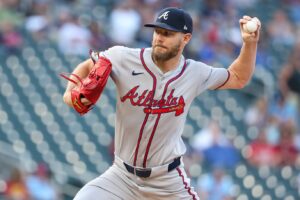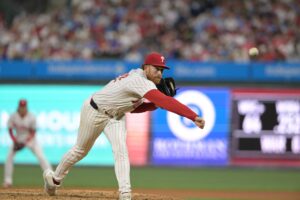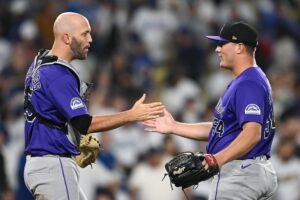Atlanta Braves third baseman Austin Riley has had a rocky big league career. After a blistering start, he hit ice rather quickly. Unfortunately, this was a rather impenetrable slowness and he couldn’t find his footing. His cold streaks at the plate were peppered by flashes of brilliance. Sadly, the cold far outweighed the hot. Soon, he was the target of many a disparaging social media post. He became something of a whipping post for a fanbase upset at many things. Armchair general managers may be a dime a dozen, but this time they appeared to get it right. Riley was severely struggling at the plate. Nevertheless, a solid glove and miles of potential kept him afloat in the big leagues. This season, his bat seems to have caught up with him. Let’s dive into his career and examine the adjustments made for this breakout season.
High School & The Minor Leagues
Right out of high school, Austin Riley was considered special. He was a two-sport player at DeSoto High School in Mississippi. However, his statistics favored baseball much more than football. While he was a decent field goal kicker, his numbers on the diamond are somewhat eye-popping. He hit .418 in his high school career with 174 hits in 138 games. Even though his power had yet to develop fully, he did have 26 homers and 42 doubles. Unfortunately, his biggest issue was his patience. A 16% walk rate did not bode well for the young star. Regardless, the Braves selected him with the 41st pick in the 2015 Draft. They shipped him off to the minor leagues on a $1.6 million deal.
His first jaunt in professional baseball did not start well. The aforementioned lack of patience caught up with him, and he went hitless in his first 16 at-bats. However, he adjusted and wound up hitting .304 with 66 hits in the Rookie League. The rest of his minor league numbers were not eye-popping. In spite of this, he rose through the ranks rather quickly. Beyond Rookie ball, his most successful season was in 2018. He spent time with both Double-A Mississippi and Triple-A Gwinnett that year. There was a short stint back in Rookie Ball as well. All told, Austin Riley hit .294 with 19 homers, 70 RBI, and 120 hits in 108 games. In 2019, he hit 15 homers in 47 games between Single-A and Triple-A. Thus his rise continued as he found himself called to the big leagues.
A Meteoric Rise & Fall
Month number one was magnificent for Austin Riley. He won National League Rookie of the Month in May 2019. The award was not unfounded. In his first 15 big league contests, he hit a whopping .356. Seven homers and 20 RBI spoke to his amazing power. He also had 21 hits, 10 runs scored, and a massive .746 slugging average. Unfortunately, even in this blistering month, holes were beginning to show. His on-base percentage sat at .397. He only walked three times in 63 plate appearances and struck out 21 times. So, if anything, the main area of concern still lay in his inability to hold the bat on his shoulder. According to FanGraphs, he swung at over half the pitches he saw that month. Unfortunately, this led to a massive downfall.
The rest of 2019 was lackluster as Austin Riley continued utilizing the same approach. He walked 16 times in 297 plate appearances (.05%) and posted an abysmal .279 on-base percentage. His OPS was .750, leading to an OPS+ of 84. The only redeeming factor was in his power as he crushed 18 dingers. However, this could not combat an otherwise underwhelming stat line. Once more, his swing percentage was in direct correlation with his production value. In total, he swung at 56.3% of the pitches he saw that year. 20.7% were swinging strikes and 41.3% were outside of the strike zone. This explains why he was unable to perform over a longer period.
2020: Disappointment for Austin Riley
Despite a shortened 2020 season, the same issues plagued Austin Riley. He struck out 49 times in 188 at-bats and walked 16 times in 206 total appearances. The light seasonal load was kind to his OBP, as it went from .279 to .301. However, his OPS+ remained at 84. His power was another issue, as it did not have the same impact (8 HRs, 7 Doubles). It was so bad, in fact, that his WAR went from 0.0 in 2019 to -0.7 in 2020. Times were rough for the Braves third baseman. Nevertheless, he showed flashes of the player he could be. His best stretch was a three-game period in which he hit .400 with seven RBI. Hope still lay in what he could do with the bat. All he needed was a chance to unlock it.
2021: Austin Riley Redemption
This season, he has had that chance. Currently, he holds a .286 average with 64 hits in 65 games. He has also hit 12 homers, 31 RBI, and 10 doubles. His OPS is .862 and his OPS+ rests at a terrific 128. He’s managed to improve his WAR to 1.7, as well. All in all, things are looking up, especially in regards to his plate discipline. His swing percentage is down to 48.3%. This is still too high, but it’s heading in the right direction. Another welcomed sight is his percentage of swinging strikes. It’s gone down to around 12%. All in all, he’s showing much more patience, and it’s benefiting him immensely. He’s already set a career-high in walks for a season, with 25. His walk percentage is still only around 10%, but, again, he’s showing progress.
Overall, Austin Riley has to be considered one of the best offensive third basemen in the National League. Thanks to an improved approach at the plate, he’s taken major leaps. He’s no longer swinging at everything. Since he’s adjusted in this manner, opposing pitchers are less likely to throw him tempting pitches. By continuing to follow this type of discipline, he could become everything the Braves desire. He’s shown off his power, but he had no consistency. This season, he’s found that and so much more. Even more than that, he’s become one of the best players the team has to offer.
“Main Photo”
Embed from Getty Images
Players Mentioned:






